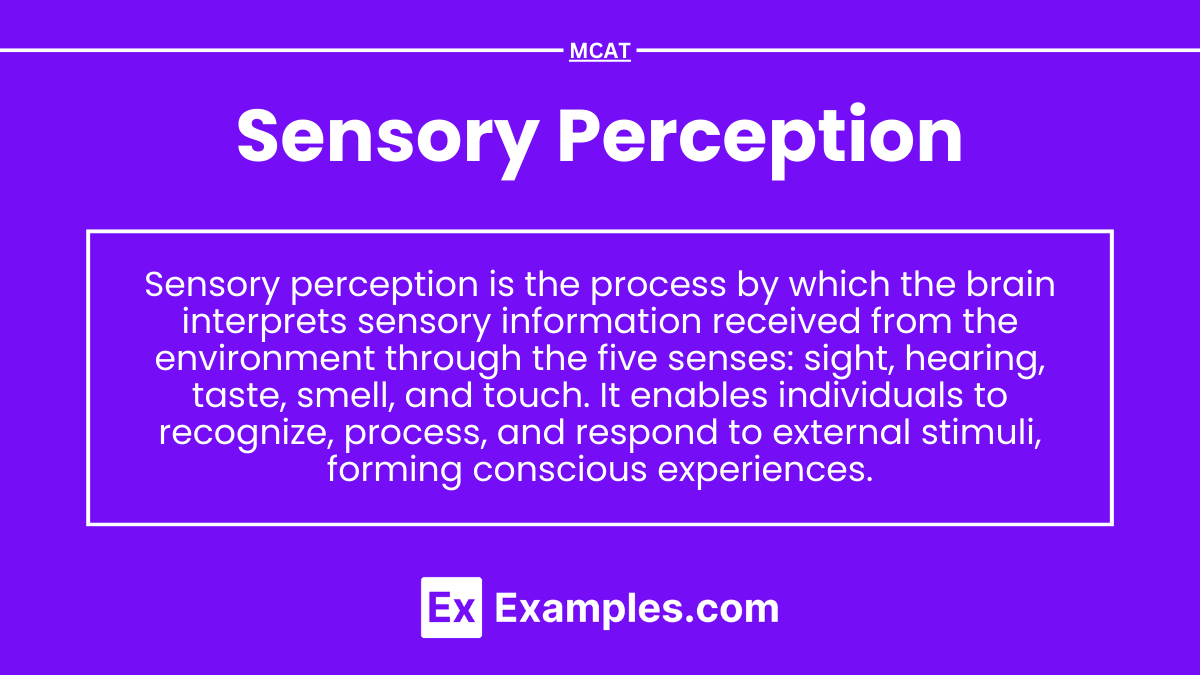Sensory Perception

- Notes
Preparing for the MCAT requires a strong grasp of sensory perception, essential for mastering Processing the Environment. Understanding how sensory stimuli are detected, transmitted, and interpreted by the brain equips you with critical insights into perception and cognition. This knowledge is vital for excelling in the MCAT and comprehending complex neural processes involved in perception.
Learning Objective
In studying Sensory Perception for the MCAT, you should develop an understanding of how sensory information is detected, transmitted, and processed by the brain. Explore the roles of sensory receptors, neural pathways, and the integration of signals from different senses. Evaluate how perception is shaped by bottom-up processing (data-driven) and top-down processing (experience-driven), and how signal detection theory applies to distinguishing between relevant stimuli and background noise. Additionally, understand how sensory adaptation adjusts responsiveness over time. Apply this knowledge to analyzing MCAT practice questions on perception, cognition, and behavior, as well as interpreting experimental data on sensory function.
Introduction To Sensory Perception
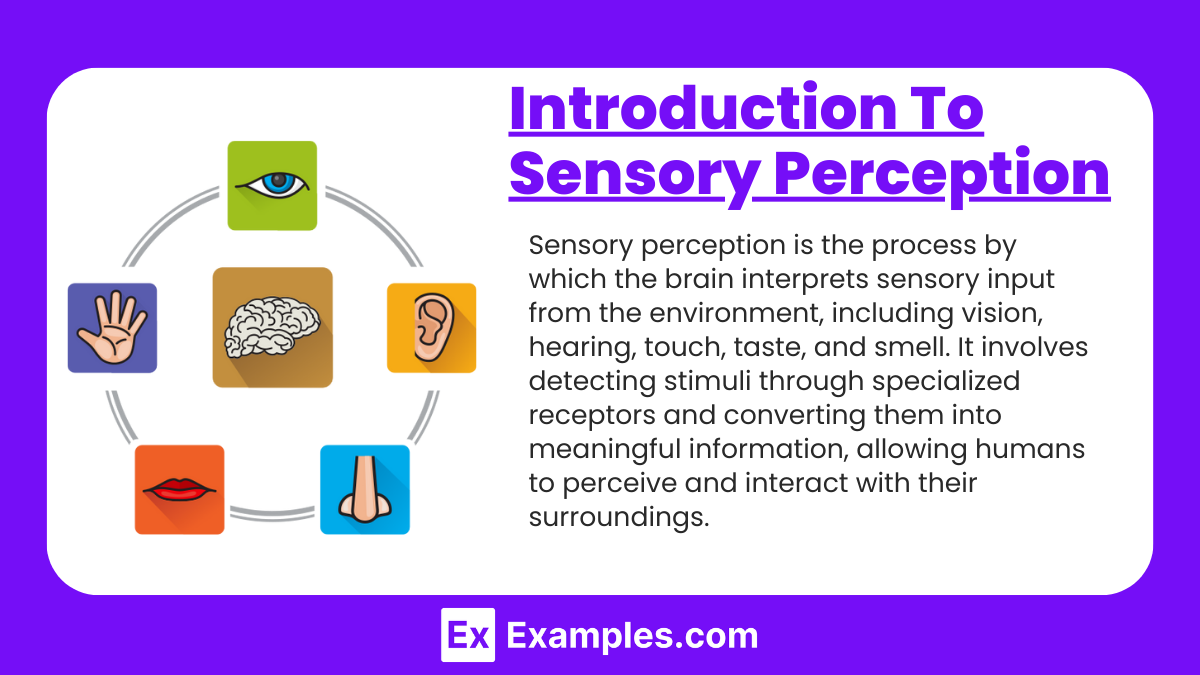
Sensory perception involves detecting, transmitting, and interpreting stimuli from the environment. The brain receives input from various senses like vision, hearing, touch, taste, and smell, transforming these signals into meaningful perceptions. Understanding this process is essential for interpreting how humans interact with their surroundings.
1. The Five Major Senses
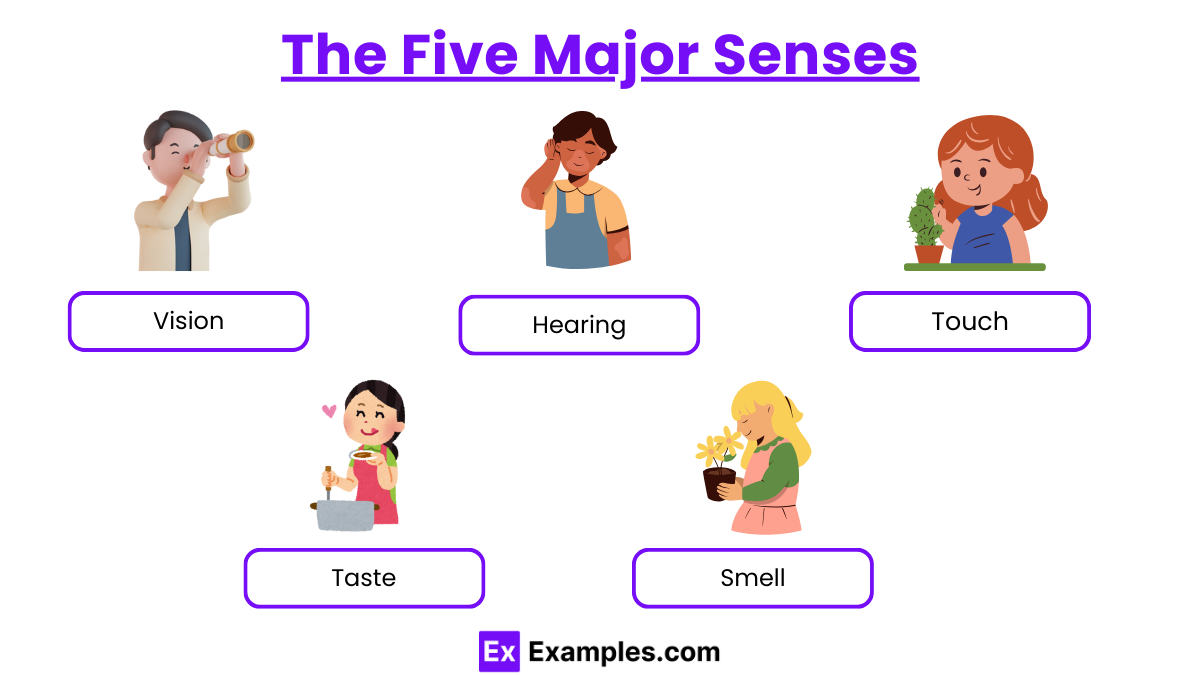
Each sense has specialized receptors and pathways:
- Vision: Detected by photoreceptors in the retina.
- Hearing: Detected by hair cells in the cochlea.
- Touch: Detected by mechanoreceptors, thermoreceptors, and nociceptors.
- Taste: Detected by taste receptors in taste buds.
- Smell: Detected by olfactory receptors in the nasal cavity.
2. Signal Detection Theory
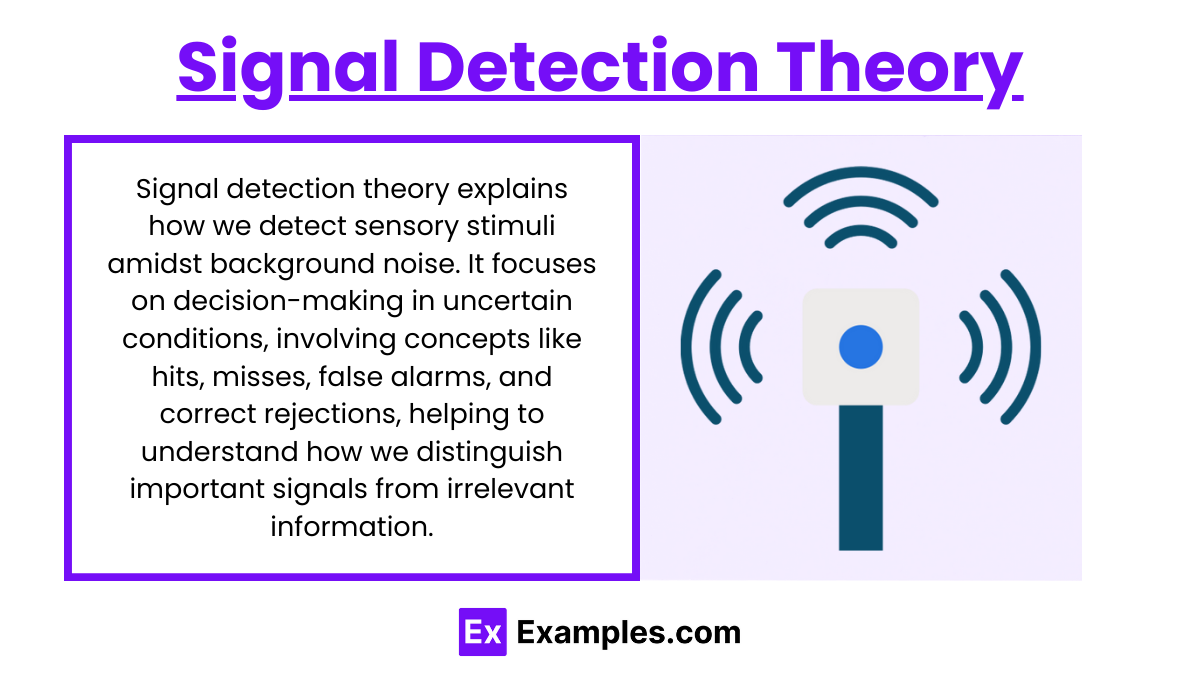
Signal Detection Theory explains how we detect and respond to stimuli in the presence of uncertainty, such as background noise. It explores how individuals discern between important sensory information and irrelevant or faint stimuli. This theory is highly relevant for understanding perception in real-world settings, where signals are often mixed with noise.
Key Concepts in Signal Detection Theory
- Hit: Correctly detecting the presence of a stimulus.
Example: Hearing your phone ring in a noisy room. - Miss: Failing to detect a stimulus that is present.
Example: Not hearing a knock at the door when music is loud. - False Alarm: Incorrectly detecting a stimulus when none is present.
Example: Thinking you heard your phone ring when it didn’t. - Correct Rejection: Correctly identifying that no stimulus is present.
Example: Realizing there was no phone call when the phone didn’t ring.
3. Bottom-Up vs. Top-Down Processing

Bottom-Up Processing
Bottom-up processing is data-driven and begins with sensory input. The brain processes this information from the most basic level, building a perception based on the raw data received by sensory receptors.
- Example: When you see an unfamiliar object, your brain processes its shape, color, and texture to identify it. You start with the sensory details and work upwards to form an understanding.
This type of processing is crucial for recognizing new objects or stimuli without relying on prior knowledge.
Top-Down Processing
Top-down processing is concept-driven and uses prior knowledge, experience, and expectations to interpret sensory information. Instead of starting from scratch, the brain applies what it already knows to make sense of new stimuli.
- Example: If you’re searching for a friend in a crowd, you use your memory of their appearance to quickly spot them. Your brain fills in gaps based on what you expect to see.
Top-down processing allows for faster and more efficient perception, especially in familiar situations where past experiences help guide interpretations.
4. Perceptual Organization
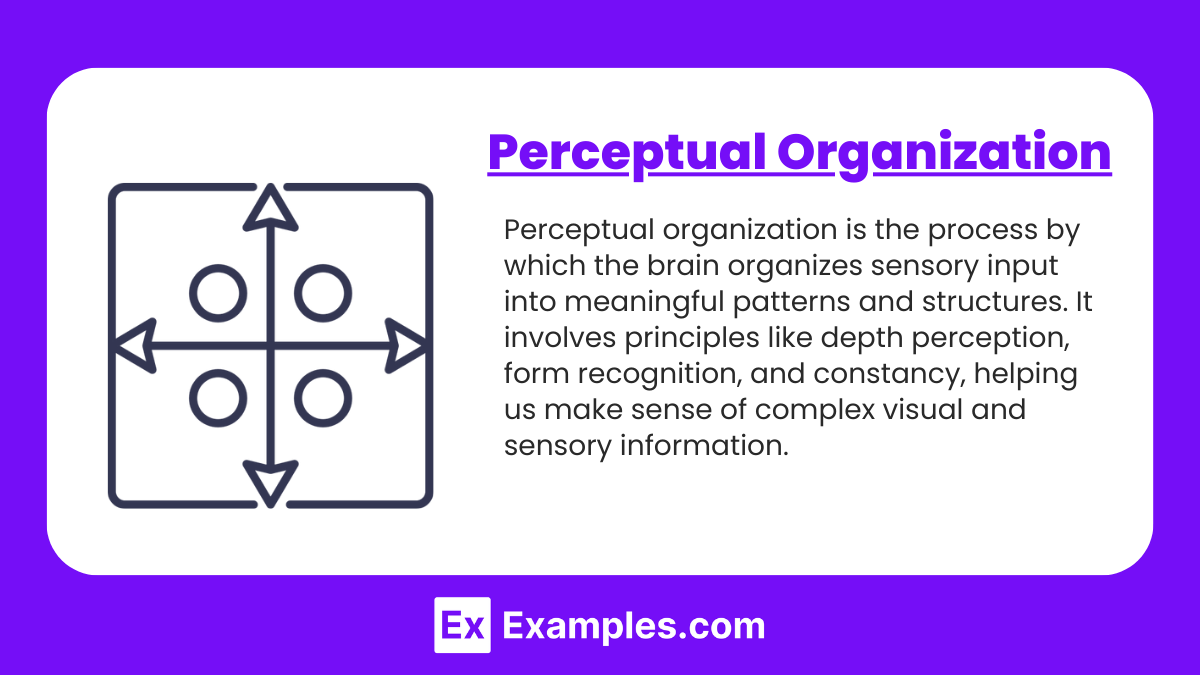
Perceptual organization is how the brain structures sensory input to make sense of the environment. It helps us perceive objects, depth, and motion in an organized way.
Key Principles of Perceptual Organization
- Perceptual Constancy
Perceiving objects as stable in size, shape, and color, even when sensory input changes. - Depth Perception
The ability to perceive the world in 3D using monocular (e.g., relative size) and binocular (e.g., retinal disparity) cues. - Form Perception
Recognizing objects by distinguishing figure from background using Gestalt principles like proximity and similarity. - Motion Perception
Detecting movement through real or apparent motion.
Examples
Example 1: Vision – Detection of Light
- Photoreceptors in the retina (rods and cones) detect light entering the eye.
- Light triggers chemical changes in these receptors, which convert the light into electrical signals sent to the brain via the optic nerve. The brain processes these signals to create visual images.
Example 2: Auditory Processing – Hearing a Sound
- Sound waves enter the ear and vibrate the eardrum, causing movement in the cochlea’s hair cells.
- Hair cells convert these vibrations into electrical signals that travel to the auditory cortex in the brain, where the sound is interpreted as speech, music, or noise.
Example 3: Touch – Feeling Pressure
- Mechanoreceptors in the skin detect physical pressure or touch.
- These receptors convert the pressure into nerve signals sent to the somatosensory cortex, where the intensity and location of the touch are processed and perceived.
Example 4: Taste – Detecting Flavors
- Taste buds on the tongue detect chemical compounds in food.
- These taste receptors convert chemical signals into electrical impulses, which are sent to the brain and processed to perceive flavors like sweet, salty, bitter, sour, and umami.
Example 5: Smell – Detecting Odors
- Olfactory receptors in the nasal cavity detect airborne chemicals.
- These receptors send electrical signals to the olfactory bulb in the brain, where odors are identified and linked to memories or emotions.
Practice Questions
Question 1:
Which part of the eye is responsible for focusing light onto the retina?
A) Cornea
B) Iris
C) Lens
D) Pupil
Answer: C) Lens
Explanation:
The lens of the eye focuses light onto the retina to form clear images. While the cornea also plays a role in bending light, the lens adjusts its shape to fine-tune the focus, ensuring light is precisely directed onto the retina. The iris controls the size of the pupil, regulating the amount of light entering the eye, but does not directly focus light.
Question 2:
Which of the following best describes the role of olfactory receptors in the process of smell?
A) They detect mechanical vibrations from sound waves.
B) They bind to specific chemical molecules in the air.
C) They transmit visual signals from the environment.
D) They respond to changes in body temperature.
Answer: B) They bind to specific chemical molecules in the air.
Explanation:
Olfactory receptors are specialized receptors in the nasal cavity that detect airborne chemicals, allowing us to perceive different smells. These receptors bind to specific odorant molecules, converting them into electrical signals that are sent to the brain for interpretation. Other senses like hearing and vision involve different receptors and pathways.
Question 3:
In signal detection theory, what is it called when a stimulus is correctly detected in the presence of noise?
A) Hit
B) Miss
C) False Alarm
D) Correct Rejection
Answer: A) Hit
Explanation:
In signal detection theory, a hit occurs when a stimulus is correctly detected despite background noise. A miss happens when the stimulus is present but not detected, a false alarm occurs when a stimulus is wrongly identified as present, and a correct rejection is when no stimulus is present, and none is detected.
Preparing for the MCAT requires a strong grasp of sensory perception, essential for mastering Processing the Environment. Understanding how sensory stimuli are detected, transmitted, and interpreted by the brain equips you with critical insights into perception and cognition. This knowledge is vital for excelling in the MCAT and comprehending complex neural processes involved in perception.
Learning Objective
In studying Sensory Perception for the MCAT, you should develop an understanding of how sensory information is detected, transmitted, and processed by the brain. Explore the roles of sensory receptors, neural pathways, and the integration of signals from different senses. Evaluate how perception is shaped by bottom-up processing (data-driven) and top-down processing (experience-driven), and how signal detection theory applies to distinguishing between relevant stimuli and background noise. Additionally, understand how sensory adaptation adjusts responsiveness over time. Apply this knowledge to analyzing MCAT practice questions on perception, cognition, and behavior, as well as interpreting experimental data on sensory function.
Introduction To Sensory Perception

Sensory perception involves detecting, transmitting, and interpreting stimuli from the environment. The brain receives input from various senses like vision, hearing, touch, taste, and smell, transforming these signals into meaningful perceptions. Understanding this process is essential for interpreting how humans interact with their surroundings.
1. The Five Major Senses

Each sense has specialized receptors and pathways:
Vision: Detected by photoreceptors in the retina.
Hearing: Detected by hair cells in the cochlea.
Touch: Detected by mechanoreceptors, thermoreceptors, and nociceptors.
Taste: Detected by taste receptors in taste buds.
Smell: Detected by olfactory receptors in the nasal cavity.
2. Signal Detection Theory

Signal Detection Theory explains how we detect and respond to stimuli in the presence of uncertainty, such as background noise. It explores how individuals discern between important sensory information and irrelevant or faint stimuli. This theory is highly relevant for understanding perception in real-world settings, where signals are often mixed with noise.
Key Concepts in Signal Detection Theory
Hit: Correctly detecting the presence of a stimulus.
Example: Hearing your phone ring in a noisy room.Miss: Failing to detect a stimulus that is present.
Example: Not hearing a knock at the door when music is loud.False Alarm: Incorrectly detecting a stimulus when none is present.
Example: Thinking you heard your phone ring when it didn't.Correct Rejection: Correctly identifying that no stimulus is present.
Example: Realizing there was no phone call when the phone didn’t ring.
3. Bottom-Up vs. Top-Down Processing

Bottom-Up Processing
Bottom-up processing is data-driven and begins with sensory input. The brain processes this information from the most basic level, building a perception based on the raw data received by sensory receptors.
Example: When you see an unfamiliar object, your brain processes its shape, color, and texture to identify it. You start with the sensory details and work upwards to form an understanding.
This type of processing is crucial for recognizing new objects or stimuli without relying on prior knowledge.
Top-Down Processing
Top-down processing is concept-driven and uses prior knowledge, experience, and expectations to interpret sensory information. Instead of starting from scratch, the brain applies what it already knows to make sense of new stimuli.
Example: If you're searching for a friend in a crowd, you use your memory of their appearance to quickly spot them. Your brain fills in gaps based on what you expect to see.
Top-down processing allows for faster and more efficient perception, especially in familiar situations where past experiences help guide interpretations.
4. Perceptual Organization

Perceptual organization is how the brain structures sensory input to make sense of the environment. It helps us perceive objects, depth, and motion in an organized way.
Key Principles of Perceptual Organization
Perceptual Constancy
Perceiving objects as stable in size, shape, and color, even when sensory input changes.Depth Perception
The ability to perceive the world in 3D using monocular (e.g., relative size) and binocular (e.g., retinal disparity) cues.Form Perception
Recognizing objects by distinguishing figure from background using Gestalt principles like proximity and similarity.Motion Perception
Detecting movement through real or apparent motion.
Examples
Example 1: Vision - Detection of Light
Photoreceptors in the retina (rods and cones) detect light entering the eye.
Light triggers chemical changes in these receptors, which convert the light into electrical signals sent to the brain via the optic nerve. The brain processes these signals to create visual images.
Example 2: Auditory Processing - Hearing a Sound
Sound waves enter the ear and vibrate the eardrum, causing movement in the cochlea's hair cells.
Hair cells convert these vibrations into electrical signals that travel to the auditory cortex in the brain, where the sound is interpreted as speech, music, or noise.
Example 3: Touch - Feeling Pressure
Mechanoreceptors in the skin detect physical pressure or touch.
These receptors convert the pressure into nerve signals sent to the somatosensory cortex, where the intensity and location of the touch are processed and perceived.
Example 4: Taste - Detecting Flavors
Taste buds on the tongue detect chemical compounds in food.
These taste receptors convert chemical signals into electrical impulses, which are sent to the brain and processed to perceive flavors like sweet, salty, bitter, sour, and umami.
Example 5: Smell - Detecting Odors
Olfactory receptors in the nasal cavity detect airborne chemicals.
These receptors send electrical signals to the olfactory bulb in the brain, where odors are identified and linked to memories or emotions.
Practice Questions
Question 1:
Which part of the eye is responsible for focusing light onto the retina?
A) Cornea
B) Iris
C) Lens
D) Pupil
Answer: C) Lens
Explanation:
The lens of the eye focuses light onto the retina to form clear images. While the cornea also plays a role in bending light, the lens adjusts its shape to fine-tune the focus, ensuring light is precisely directed onto the retina. The iris controls the size of the pupil, regulating the amount of light entering the eye, but does not directly focus light.
Question 2:
Which of the following best describes the role of olfactory receptors in the process of smell?
A) They detect mechanical vibrations from sound waves.
B) They bind to specific chemical molecules in the air.
C) They transmit visual signals from the environment.
D) They respond to changes in body temperature.
Answer: B) They bind to specific chemical molecules in the air.
Explanation:
Olfactory receptors are specialized receptors in the nasal cavity that detect airborne chemicals, allowing us to perceive different smells. These receptors bind to specific odorant molecules, converting them into electrical signals that are sent to the brain for interpretation. Other senses like hearing and vision involve different receptors and pathways.
Question 3:
In signal detection theory, what is it called when a stimulus is correctly detected in the presence of noise?
A) Hit
B) Miss
C) False Alarm
D) Correct Rejection
Answer: A) Hit
Explanation:
In signal detection theory, a hit occurs when a stimulus is correctly detected despite background noise. A miss happens when the stimulus is present but not detected, a false alarm occurs when a stimulus is wrongly identified as present, and a correct rejection is when no stimulus is present, and none is detected.

